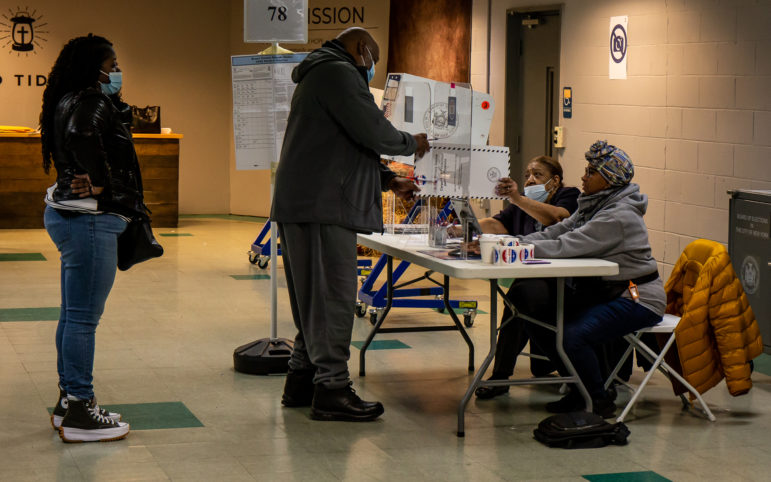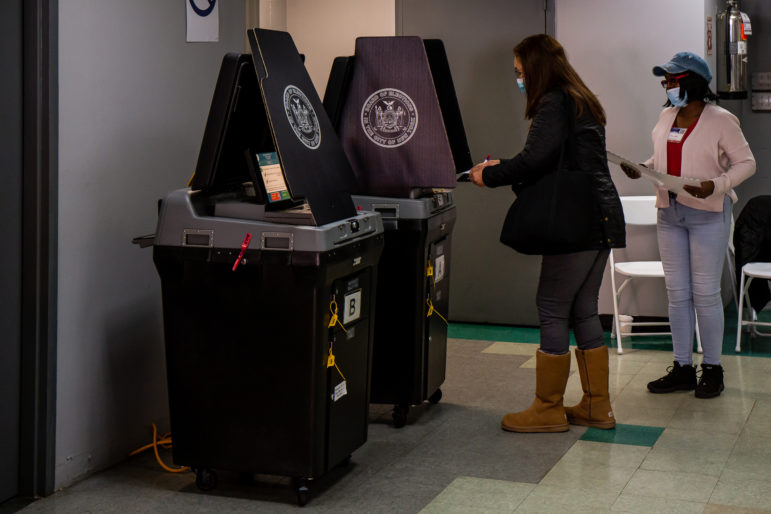Nearly 1.7 million people across the five boroughs turned up to vote for governor in Tuesday’s general election—up significantly from the June primary, but still lower than the number of ballots cast in the last gubernatorial race in 2018.

Adi Talwar
Voters checking in at the poll site at JHS 80 on Mosholu Parkway in the Bronx.This story was produced by student reporters in the journalism program at CUNY’s Lehman College: Nathaly Cisneros, Coral Reyes, Dennis Casiano, Ryan Pullido, Aminata Gueye, Keiwana Grant-Floyd, Amber Rivers and Emmanuel Valerio. With additional reporting by Jeanmarie Evelly and Adi Talwar.
Nearly 1.7 million New York City residents turned up to vote for governor in Tuesday’s general election—up significantly from the June primary but still lower than the number of ballots cast in the last general gubernatorial election in 2018, when more than 2 million people took part.
Incumbent Democrat Kathy Hochul, the state’s first woman to assume the office of governor, won her first full term on Tuesday, fending off a challenge from Republican Congressman Lee Zeldin. While Zeldin earned 47 percent of votes statewide, he fared worse in the left-leaning city, with 30 percent of votes.
In other races, New Yorkers re-elected Attorney General Letitia James, Comptroller Tom DiNapoli and U.S. Sen. Chuck Schumer. Incumbents retained their seats in all of the city’s House races—including Republican Nicole Malliotakis, who beat Democrat Max Rose on Staten Island. Republican George Santos won the vacant 3rd Congressional district that spans eastern Queens and Long Island, while Democrat Dan Goldman was elected to represent the newly redrawn 10th district in Brooklyn and Lower Manhattan.
City Limits’ reporters spent Election Day speaking to voters at poll sites across the five boroughs, who cited a multitude of reasons motivating their votes: concerns about cost of living, crime, homelessness and climate change were common sentiments, as was abortion access and reproductive rights.
“People should always have a choice over their bodies,” said Sylvia Turner, who voted at P.S. 53 in Morrisania around noon Tuesday, choosing Hochul over pro-life Zeldin.
“Women’s rights,” Brooklyn voter Ann Stanislaus, 68, cited as one of many reasons she voted for democratic candidates. “Hopefully having a female governor will get these things addressed.”
“I voted yes for Kathy Hochul because of her views on abortion,” echoed Bronx voter Irene Stanton. “It is a personal decision that the government shouldn’t have control over.”
“Ever since I became a citizen, I’ve voted Democrat because they, to me, are the ones who most help the Hispanic community,” Francia Reye told a reporter in Spanish as she voted at P.S. 94 in The Bronx.
Several voters said public safety was top of mind, an issue that has dominated this election cycle, particularly among Republican candidates, including Zeldin, who’ve pushed to link an uptick in crime since the pandemic with the state’s 2019 bail reforms—though most experts say there’s no evidence of a connection between the two.
“I’m really worried about crime, inflation and I would like to walk along my streets at night,” said Rosemary Moran who voted around 1 p.m. in Woodside, Queens.
“I switched to Republican too, for the same issues,” said Joseph Moran, who voted with her. “Crime is up, inflation is up, the crimes on the subways, and these politicians don’t listen to us.”

Adi Talwar
Voters at the Glad Tidings Assembly of God on Van Cortlandt Avenue in the BronxJoseph Implatini, 40, who voted at the Hebrew Institute in Riverdale, had another common complaint: the cost of living in New York is just too expensive.
“I feel like rent has been extremely high recently and I’m afraid that it’s going to keep going up, and would be hard for my kids to afford to live on their own from the way things are going,” he said.
Implatini voted in favor of proposal included on the ballot that would require the city to develop a “true cost of living” measure, which supporters say would help lawmakers develop policies around housing and social welfare more accurately aligned with New Yorker’s budgets.
“It’s about goddamn time someone looked into it,” 23-year-old Jessica Perez told a reporter while voting at I.S. 166 in The Bronx. “I started working from a young age just to try and save money and move out, but I can’t seem to ever make enough for a down payment. I know they have rent lotteries, but you [have to] get real lucky with that.”
Tuesday brought the city’s tumultuous 2022 election cycle to an end—a year when redistricting and an ensuing legal battle over how to do it resulted in two separate summer primaries. New York City voters will next return to the polls in June 2023, where they’ll vote for the next batch of New York City Council members.
“I want them to implement other plans to help the development of New York, and the diversity of New York and hear the needs of the people,” Loretta Sow, 64, said as she voted Tuesday at M.S Houses in Upper Manhattan. “Housing, crime. We got that homeless issue. Health and things concerning seniors. How are they making things better for us?”











